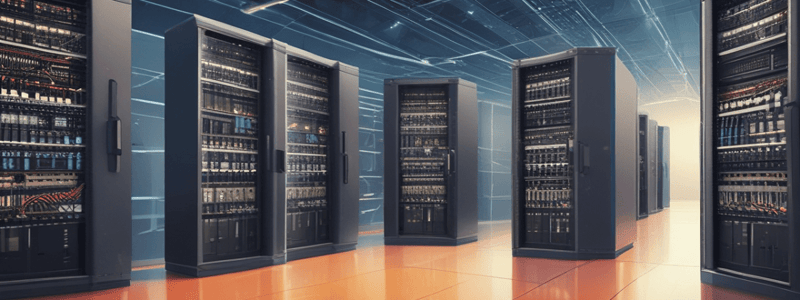Podcast
Questions and Answers
What is the primary function of a Type 1 hypervisor?
What is the primary function of a Type 1 hypervisor?
- To connect multiple virtual machines to a physical switch
- To run one or more virtual machines on a host (correct)
- To provide network connectivity between leaf nodes and the spine
- To manage multiple physical hosts in a data center
What is the purpose of the virtual switch in a hypervisor?
What is the purpose of the virtual switch in a hypervisor?
- To connect virtual machines to a physical network
- To configure the spine network in a data center
- To allow virtual machines to communicate with each other within the hypervisor (correct)
- To manage network traffic between multiple hosts
In a data center architecture, what is the term for the top tier of the two-layer hierarchy?
In a data center architecture, what is the term for the top tier of the two-layer hierarchy?
- Backbone
- Leaf nodes (correct)
- Spine
- Core
What is the term for the layer that interconnects leaf nodes in a data center architecture?
What is the term for the layer that interconnects leaf nodes in a data center architecture?
In a scenario with multiple hosts, what is required for a virtual machine on one host to communicate with a virtual machine on another host?
In a scenario with multiple hosts, what is required for a virtual machine on one host to communicate with a virtual machine on another host?
What is the primary function of ESXi hosts in a data center architecture?
What is the primary function of ESXi hosts in a data center architecture?
What is the benefit of using a virtual switch within a hypervisor?
What is the benefit of using a virtual switch within a hypervisor?
What is the term for the machines that run a hypervisor and virtual machines in a data center architecture?
What is the term for the machines that run a hypervisor and virtual machines in a data center architecture?
What is the primary function of the spine in a two-tier architecture?
What is the primary function of the spine in a two-tier architecture?
What type of switches are used to connect hosts to the network?
What type of switches are used to connect hosts to the network?
What is the term for traffic that stays within the data center and goes between hosts?
What is the term for traffic that stays within the data center and goes between hosts?
What is the benefit of using a two-tier architecture?
What is the benefit of using a two-tier architecture?
What is the path of traffic from a host to another host in a two-tier architecture?
What is the path of traffic from a host to another host in a two-tier architecture?
What is the term for traffic that leaves the data center and goes out to the public internet?
What is the term for traffic that leaves the data center and goes out to the public internet?
What is the advantage of having a full mesh between spine switches and leaf switches?
What is the advantage of having a full mesh between spine switches and leaf switches?
What is the purpose of using top-of-rack switches?
What is the purpose of using top-of-rack switches?
What is the advantage of having a two-tier architecture with a full mesh between spine switches and leaf switches?
What is the advantage of having a two-tier architecture with a full mesh between spine switches and leaf switches?
What is the difference between a spine switch and a leaf switch?
What is the difference between a spine switch and a leaf switch?
What is the primary purpose of using NetFlow in a data center?
What is the primary purpose of using NetFlow in a data center?
What is the characteristic of traffic flows in a data center according to the two-tier architecture?
What is the characteristic of traffic flows in a data center according to the two-tier architecture?
What is the typical connection between hosts and storage devices in a data center?
What is the typical connection between hosts and storage devices in a data center?
What is the purpose of the next video in the series?
What is the purpose of the next video in the series?
What is the primary benefit of using a two-tier architecture with fault tolerance in a data center?
What is the primary benefit of using a two-tier architecture with fault tolerance in a data center?
What type of traffic flows are typically found in a data center?
What type of traffic flows are typically found in a data center?
What is the primary function of sensors and other devices in the network?
What is the primary function of sensors and other devices in the network?
What is the primary reason for using dedicated networks for storage area networks?
What is the primary reason for using dedicated networks for storage area networks?
Flashcards are hidden until you start studying
Study Notes
Data Center Network Architecture
-
A two-tier network architecture is commonly used in data centers
The three-tier network architecture is not necessarily inferior to the two-tier network architecture but rather serves different purposes and has its own advantages and disadvantages. In a three-tier architecture, there are three distinct layers: the core layer, distribution layer, and access layer. The distribution layer acts as an aggregation point for the connections from the access layer and provides routing and filtering functions.
While the two-tier architecture is simpler and more cost-effective, the three-tier architecture offers more flexibility and scalability. It allows for better segmentation of network functions and can provide enhanced security by segregating different parts of the network. Additionally, the three-tier architecture can better accommodate growth and changes in the network over time.
Ultimately, the choice between a two-tier and three-tier network architecture depends on the specific requirements of the data center, including factors such as size, complexity, scalability needs, and budget constraints. Each architecture has its own strengths and weaknesses, and the best choice will depend on the unique considerations of the organization.
-
The two tiers are:
- Leaf nodes (also called top-of-rack switches): where devices and servers connect
- Spine (also called backbone): interconnects the leaf nodes
Leaf Nodes (Top-of-Rack Switches)
- Each leaf node is connected to multiple hosts (e.g., ESXi hosts) in a rack, typically through high-speed connections such as 10GbE or 40GbE Ethernet. This configuration enables efficient communication and data transfer between the hosts.
- Each host has a Type 1 hypervisor (e.g., VMware's ESXi) running multiple virtual machines (VMs), which are isolated from each other and from the physical host hardware. This allows for increased virtualization and resource utilization.
- Each VM can connect to a virtual switch, which allows VMs to communicate with each other without leaving the host. This enables VMs to communicate with each other and share resources, such as storage and networking.
- Each leaf node has multiple network adapters, providing fault tolerance and connections to the spine. This ensures that if one network adapter fails, the other adapters can take over, maintaining network connectivity and reducing downtime.
- In addition, each leaf node is typically equipped with physical network interfaces (PNIs) and virtual network interfaces (VNICs). PNIs are used to connect to the external network, while VNICs are used to connect to the virtual network and enable VM-to-VM communication.
Spine (Backbone)
- The spine is the backbone of the network, interconnecting the leaf nodes
- The spine consists of multiple spine switches (e.g., SPINE1 and SPINE2) with full mesh connections to each leaf switch
- The spine provides fault tolerance and equal distance between each host and every other host
East-West Traffic
- East-west traffic refers to traffic between hosts and VMs within the data center
- This type of traffic is common in data centers and is facilitated by the two-tier architecture
- East-west traffic is represented by arrows going left and right across the infrastructure
North-South Traffic
- North-south traffic refers to traffic that leaves the data center and goes out to the public internet or other networks outside the data center
- This type of traffic is represented by arrows going up and down, leaving the spine and going out to the public internet
Traffic Analysis
- Tools like NetFlow can be used to measure and identify traffic flows in the data center
- Traffic analysis can help determine the ratio of east-west to north-south traffic in the data center
Storage in Data Centers
- In most data centers, storage is not directly connected to the hosts
- Network-accessible storage is commonly used, and special networks and architectures are dedicated for storage area networks (SANs)
Studying That Suits You
Use AI to generate personalized quizzes and flashcards to suit your learning preferences.




